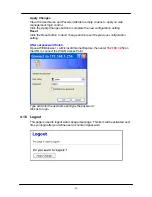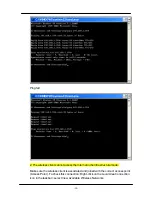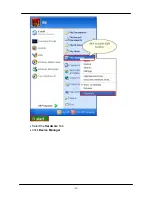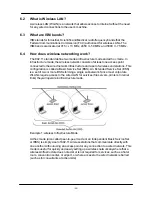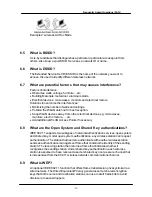
-46-
WEP relies on a secret key that is shared between a mobile station (e.g. a laptop
with a wireless Ethernet card) and an access point (i.e. a base station). The secret
key is used to encrypt packets before they are transmitted, and an integrity check is
used to ensure that packets are not modified in transit.
6.10
What is Fragment Threshold?
The proposed protocol uses the frame fragmentation mechanism defined in IEEE
802.11 to achieve parallel transmissions. A large data frame is fragmented into
several fragments each of size equal to fragment threshold. By tuning the fragment
threshold value, we can get varying fragment sizes. The determination of an efficient
fragment threshold is an important issue in this scheme. If the fragment threshold is
small, the overlap part of the master and parallel transmissions is large. This means
the spatial reuse ratio of parallel transmissions is high. In contrast, with a large
fragment threshold, the overlap is small and the spatial reuse ratio is low. However
high fragment threshold leads to low fragment overhead. Hence there is a trade-off
between spatial re-use and fragment overhead.
Fragment threshold is the maximum packet size used for fragmentation. Packets
larger than the size programmed in this field will be fragmented.
If you find that your corrupted packets or asymmetric packet reception (all send
packets, for example). You may want to try lowering your fragmentation threshold.
This will cause packets to be broken into smaller fragments. These small fragments,
if corrupted, can be resent faster than a larger fragment. Fragmentation increases
overhead, so you'll want to keep this value as close to the maximum value as
possible.
6.11
What is RTS (Request To Send) Threshold?
The RTS threshold is the packet size at which packet transmission is governed by
the RTS/CTS transaction. The IEEE 802.11-1997 standard allows for short packets
to be transmitted without RTS/CTS transactions. Each station can have a different
RTS threshold. RTS/CTS is used when the data packet size exceeds the defined
RTS threshold. With the CSMA/CA transmission mechanism, the transmitting station
sends out an RTS packet to the receiving station, and waits for the receiving station
to send back a CTS (Clear to Send) packet before sending the actual packet data.
This setting is useful for networks with many clients. With many clients, and a high
network load, there will be many more collisions. By lowering the RTS threshold,
there may be fewer collisions, and performance should improve. Basically, with a
faster RTS threshold, the system can recover from problems faster. RTS packets
consume valuable bandwidth, however, so setting this value too low will limit
performance.
6.12
What is Beacon Interval?
In addition to data frames that carry information from higher layers, 802.11 includes
management and control frames that support data transfer. The beacon frame, which
is a type of management frame, provides the "heartbeat" of a wireless LAN,
Summary of Contents for QP-WO259GHP
Page 1: ...www qpcom com User s Manual QP WO259GHP Outdoor High Power 54Mbps Wireless Access Pointr...
Page 7: ...Installation 7 WPS Button Reset Button SMA antenna connector...
Page 9: ...Installation 9 Step4 Installtheantenna Make sure the Antenna is well installed...
Page 10: ...10 Step5 Installtheupperhousing Make sure the housing is well installed...
Page 12: ...12 Step7 InstallPOEInjector DC Insertadapter...
Page 40: ...40 Select the Hardware Tab Click Device Manager...
Page 42: ...42 Look under Device Status to check that the device is working properly Click OK...





